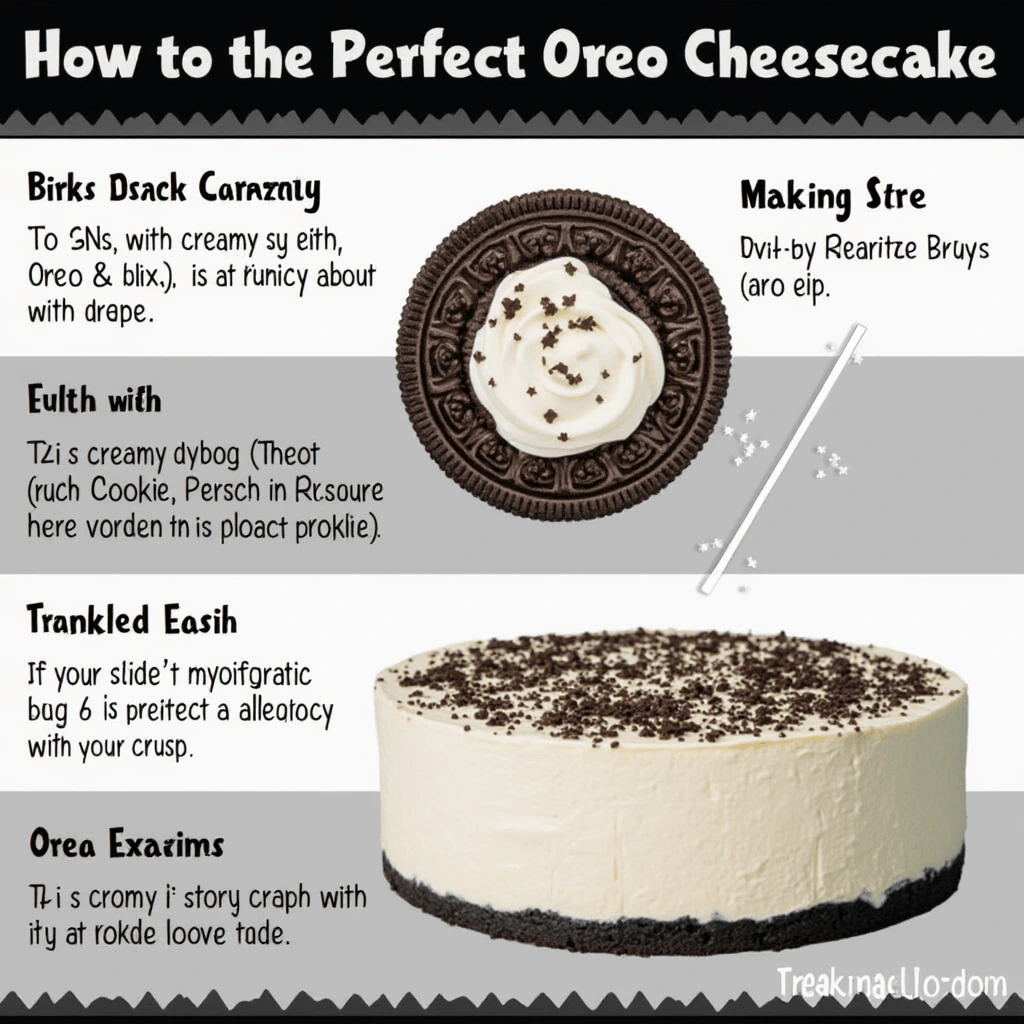Making the perfect Oreo cheesecake isn’t just about following a recipe — it’s about knowing the little tricks that take your dessert from good to truly unforgettable. Whether you’re baking it for a special occasion or just treating yourself, a few expert tips can help you achieve a smooth, creamy texture, a firm crust, and bold cookie flavor in every bite. From choosing the right ingredients to avoiding common baking mistakes, these practical tips will guide you to cheesecake success every time. Let’s take your Oreo cheesecake to the next level!
Tips for the Perfect Oreo Cheesecake
For more expert baking advice, check out King Arthur Baking Company’s guide to perfect cheesecakes.
Use Room Temperature Ingredients
One of the most important — and often overlooked — steps to achieving a smooth and creamy Oreo cheesecake is using room temperature ingredients, especially the cream cheese, eggs, and sour cream or heavy cream. Cold ingredients can lead to a lumpy batter and uneven texture, which can affect both the appearance and mouthfeel of your cheesecake.
Why It Matters :
Room temperature cream cheese blends more easily and evenly with sugar and other ingredients, preventing clumps and ensuring a velvety consistency. When the ingredients are at similar temperatures, they emulsify better, resulting in a cohesive, smooth batter that bakes evenly. Cold eggs or dairy can cause the mixture to seize up or become gritty, which may lead to cracks or a dense texture after baking.
Best Practices:
- Cream cheese: Remove from the fridge at least 1–2 hours before baking.
- Eggs: Let sit at room temperature for about 30 minutes before adding to the batter.
- Heavy cream or sour cream: Set out at least 30–60 minutes before use to take the chill off.
If you’re short on time, you can gently warm cream cheese in the microwave in 10-second intervals, but be careful not to overheat it. Similarly, eggs can be placed in a bowl of warm (not hot) water for 10 minutes to speed up the process.
Taking the extra step to use room temperature ingredients will help you create a silky, lump-free batter that bakes evenly and delivers the indulgent, creamy texture that makes Oreo cheesecake so irresistible.
Avoid Overmixing
When making cheesecake, mixing your ingredients too much can be one of the most common — and most damaging — mistakes. While it might seem like more mixing leads to a smoother batter, overmixing actually introduces excess air into the mixture, which can cause the cheesecake to rise too much in the oven and then collapse or crack as it cools.
Why Overmixing Is a Problem:
Too much air in your batter creates bubbles that expand and then deflate during baking. This not only affects the structure of the cheesecake but can also lead to surface cracks and a dense, rubbery texture. A perfect Oreo cheesecake should be rich, creamy, and smooth — not airy or sponge-like.
How to Mix Properly:
- Start Slow: Mix your cream cheese just until it’s smooth and free of lumps. Use a low speed to avoid whipping too much air into the batter.
- Add Eggs Last: Add your eggs one at a time and mix just until incorporated. Eggs hold air more than any other ingredient, so it’s important not to overbeat them.
- Use the Right Tools: A stand mixer or hand mixer on the lowest setting is ideal. Or you can mix by hand using a spatula or whisk for more control.
Bonus Tip:
If you accidentally overmix, you can gently tap the bowl on the counter a few times to bring air bubbles to the surface before pouring the batter into your pan. Also, using a water bath during baking can help prevent cracking if the batter has more air than ideal.
Keeping your mixing gentle and minimal ensures that your Oreo cheesecake comes out ultra-creamy, smooth, and bakery-quality — without any cracks or dryness.
Wrap Your Pan If Baking
If you’re baking your Oreo cheesecake, one of the most important steps to ensure a smooth and crack-free dessert is wrapping your springform pan with foil. This might seem like a small detail, but it plays a big role in achieving that perfect creamy texture and even bake.
Why Wrapping Your Pan Matters:
Most baked cheesecakes are best when cooked in a water bath (also known as a bain-marie). This technique helps regulate the temperature and adds steam to the oven, preventing the cheesecake from drying out, cracking, or baking unevenly. However, springform pans aren’t watertight. Without wrapping, water can easily seep in and ruin your crust, leaving it soggy.
How to Wrap Your Pan Properly:
- Use heavy-duty aluminum foil. Lay out two large sheets and cross them under the bottom of your pan.
- Wrap the foil tightly. Press the foil up the sides of the pan, making sure there are no tears or gaps where water could leak through.
- Double-wrap if needed. For extra security, use an additional layer of foil or even place the wrapped pan inside a slightly larger cake pan before setting it in the water bath.
Bonus Tips:
- Don’t skip this step, even if your pan seems secure — it’s better to be safe than end up with a wet crust.
- After wrapping, test your setup by gently placing the pan in a dry roasting tray and pouring water around it. If the foil keeps everything dry, you’re good to go!
By wrapping your springform pan correctly, you ensure a stress-free baking process and a perfectly set, beautifully creamy Oreo cheesecake — every single time.
Chill Overnight
As tempting as it might be to slice into your Oreo cheesecake as soon as it cools, chilling it overnight is essential for achieving the best texture and flavor. Cheesecake needs time to fully set, firm up, and allow the flavors to meld together — and there’s no shortcut that can replace a good, long chill.
Why Chilling Matters:
When your cheesecake comes out of the oven (or is done setting if it’s no-bake), it’s still quite soft. Chilling it for at least 6–8 hours — ideally overnight — allows the filling to firm up into that dense, creamy consistency you expect from a classic cheesecake. This also makes slicing easier and cleaner.
Additionally, during the chill time, the Oreo flavors infuse even more into the filling, enhancing the overall richness and depth. It’s the final step that transforms a homemade dessert into a bakery-quality treat.
Tips for Perfect Chilling:
- Leave it uncovered for the first hour to let residual heat escape, then cover loosely with plastic wrap or foil.
- Refrigerate for at least 8 hours, but overnight is ideal for best results.
- Place on a flat, stable shelf in your fridge to avoid disturbing the surface or causing dents.
Optional (But Worth It):
If you want extra-stable slices, pop the cheesecake in the freezer for 30 minutes before serving. Just don’t store it in the freezer long-term unless you’re prepping it ahead and plan to thaw it slowly in the fridge later.
Taking the time to chill your Oreo cheesecake overnight ensures you get that creamy, dreamy texture with every bite — and trust us, it’s worth the wait.

